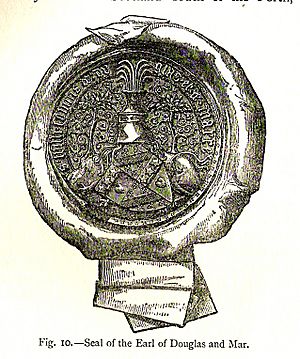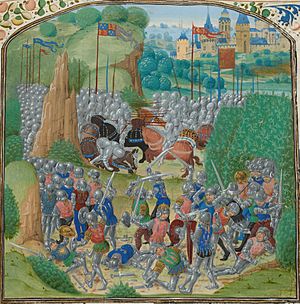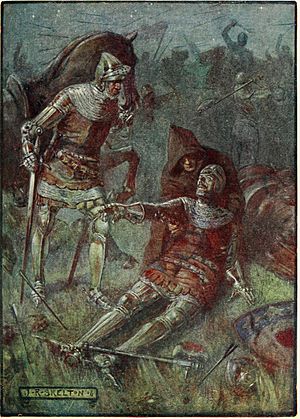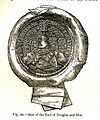James Douglas, 2nd Earl of Douglas facts for kids
Quick facts for kids
James Douglas
|
|
|---|---|
| Earl of Douglas Earl of Mar Earl of Douglas |
|

Seal of the 2nd Earl of Douglas and Mar
|
|
| Predecessor | William Douglas, 1st Earl of Douglas |
| Successor | Archibald Douglas, 3rd Earl of Douglas |
| Born | 1358 Scotland |
| Died | 5 or 19 August 1388 killed at Otterburn, Northumberland |
| Buried | 1388 Melrose Abbey |
| Noble family | Douglas |
| Issue | William Douglas of Drumlanrig (illegitimate) Archibald Douglas (illegitimate) |
| Father | William Douglas, 1st Earl of Douglas |
| Mother | Margaret, Countess of Mar |
Sir James Douglas (born around 1358) was an important and powerful leader in Scotland. He was known as the 2nd Earl of Douglas and Mar. An "Earl" was a high-ranking noble who controlled a lot of land and had great influence. James Douglas played a big part in the wars between Scotland and England. He is remembered for his bravery and for leading Scottish forces in battle. He died in 1388 during a famous battle called Otterburn.
Contents
Growing Up and Becoming a Knight
James Douglas was the oldest son of William Douglas, 1st Earl of Douglas and Margaret, Countess of Mar. This meant he would inherit his father's titles and lands. By 1380, he had become a knight. He was then known as Sir James Douglas of Liddesdale.
His father had some disagreements with King Robert II. But they became friends again when James agreed to marry Princess Isabel. She was the daughter of King Robert II. This marriage helped to make the powerful Douglas family even closer to the Scottish throne.
Becoming the Earl of Douglas
In May 1384, James's father passed away. James then became the 2nd Earl of Douglas. Around this time, some French visitors arrived in Scotland. They wanted to arrange a truce, or a temporary peace, between Scotland and England. Scotland and France were allies against England.
While these talks were happening, more French knights arrived. They offered to help the Scots fight the English. The new Earl of Douglas and Sir David Lindsay gathered their soldiers. They joined forces with the French knights.
Raids into England
Douglas and his allies led a raid into England. They attacked lands belonging to the powerful English families of Percy and Mowbray. During this time, the Scots agreed to a truce that would last until May of the next year. The French knights went home, but they promised to return.
When the truce ended in 1385, Douglas started fighting the English again. The French kept their promise and arrived in Scotland with more knights, armor, and money. The French leader, Jean de Vienne, joined forces with the Scots.
The English army, led by Richard II of England, was much larger than the Franco-Scottish army. Douglas wisely decided not to fight them directly. Instead, he let the English advance to Edinburgh. The English army destroyed abbeys and burned towns, including Haddington and the capital city itself.
Douglas responded with a counter-attack. He led a destructive raid into England, reaching Carlisle and Durham. Soon, disagreements arose between the French and Scottish allies. The French returned home at the end of the year.
In 1386, Douglas led another raid into England. He attacked and burned the town of Cockermouth. This showed his continued determination to fight the English.
The Battle of Otterburn and Death
Planning the Invasion
In 1388, King Richard II of England was having problems with his own nobles. This seemed like a good time for Scotland to invade and get revenge for the destruction of 1385.
The Scottish nobles met in Aberdeen and decided to attack. They gathered their armies in Jedburgh in August. An English spy found out about their plans. The English leader, Percy, was planning a counter-attack. So, the Scottish commanders decided to split their army.
One part of the army went west into Cumberland. The other, smaller force, led by Douglas, went east to attack Northumberland.
Facing Hotspur at Newcastle
Douglas's force entered England through Redesdale. They destroyed the countryside as they went south to Brancepeth. From there, they turned east to surround Newcastle.
Newcastle was defended by Percy's sons, Sir Henry Percy, known as "Hotspur," and his brother Sir Ralph Percy. Their father, Northumberland, stayed at Alnwick Castle. He hoped to trap Douglas if he tried to return to Scotland.
The Scots did not have the right equipment to attack the castle. So, they set up camp around it. For a week, there were many small fights and challenges for single combat. Douglas challenged Hotspur to a duel. Douglas won and captured Hotspur's special flag, called a pennon.
According to a writer named Jean Froissart, Douglas said he would take the pennon to Scotland and display it. Hotspur replied, "By God! You will never leave Northumberland alive with that."
The Battle of Otterburn
The next day, the Scots moved their camp to Ponteland, where they destroyed its castle. Then they went to Otterburn, about 30 miles from Newcastle. Douglas seemed to be waiting to see if Hotspur would follow.
Douglas chose a camp in a wood to protect his soldiers from English archers. But on the evening of August 5 or 19, the Percys surprised the Scots. A fierce battle began in the moonlight. Douglas was badly wounded during the fight. Because it was dark and confusing, his men did not know he was hurt. They kept fighting bravely.
The Scots won the battle, capturing Hotspur and many other English soldiers. Douglas's body was found on the battlefield the next day. Even though they were sad to lose their leader, the Scots were encouraged by their victory. They managed to scare off English reinforcements the next day.
Douglas's body was taken back across the border into Scotland. He was buried at Melrose Abbey. The story of this battle, told by Froissart, inspired famous English and Scottish songs called The Ballad of Chevy Chase and The Battle of Otterburn.
Family Life
James Douglas married Isabel, a daughter of King Robert II of Scotland. He did not have any sons who could legally inherit his titles. His natural sons, William and Archibald, became the ancestors of other important Douglas families.
His sister, Isabel, inherited some of the family's lands and the earldom of Mar. She also made sure that the Bonjedward estate went to their half-sister, Margaret. The main earldom and lands of Douglas went to Archibald Douglas. He was a cousin of the 1st Earl and a natural son of Sir James Douglas, known as "The Good."
Images for kids







